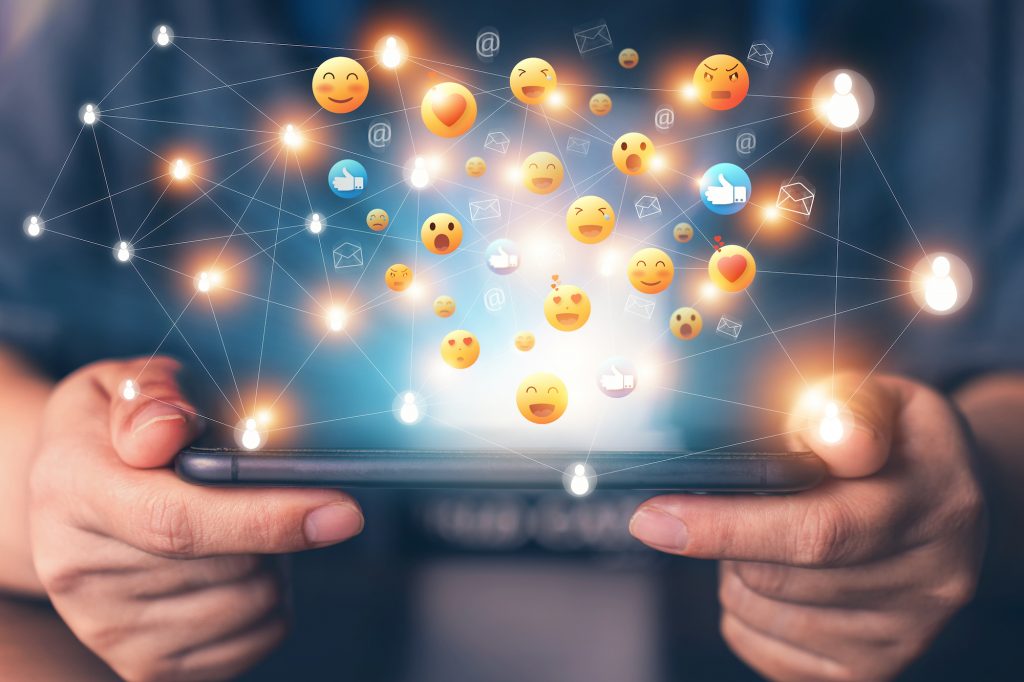❓ How to Create Custom Emoji? Who Creates Emojis at All? 🤔


Emojis are those little, expressive icons that are really powerful in our digital discussions. They have the ability to make us laugh 😂, weep 😢, or just express feelings that words can’t quite put into words.
Remember the last time you texted a friend, expressing your excitement for a plan using a string of emojis, and how those simple images brought the conversation to life?
Emojis are the secret sauce that gives our online conversations through mobile application development solutions color, subtlety, and emotion. That’s what makes them so magical ✨. And you know what? Many others share your love of emojis. ❤️
Brief History of Emojis 📜
The history of emojis began in the late 20th century when text-based communication used emoticons – simple combinations of punctuation marks – to convey emotions. People used emoticons like 🙂 to assist them in negotiating the emotional complexities of the early Internet. However, emoticons were merely the visible portion.
When Japanese artist Shigetaka Kurita created the first set of 176 symbols for a mobile internet platform in 1999, the genuine emoji revolution got underway. Little did he know that his pixelated works, initially intended for Japanese pagers, would revolutionize global communication. Today, emojis have become an indispensable part of our everyday conversations, bridging linguistic divides and acting as a worldwide language. 🌏
Although regular emojis are widely used, the emergence of custom emojis has revolutionized the messaging experience by enabling users to personalize their messages. Bespoke emoji creation has opened up new avenues for personal expression in our texts, social media posts, and even business conversations.
Who Makes and Approves Emojis? 🤔
An essential factor in the development, standardization, and acceptance of emojis is the Unicode Consortium. 🧑💼 This nonprofit organization is responsible for maintaining the Unicode Standard, which guarantees uniformity in text representation across various systems and devices. Since its founding in 1991, this international body has been in charge of emoji encoding and Unicode Standard inclusion. 📜
The Emoji Approval Process
Before a new emoji appears on our keyboards, it must undergo a rigorous procedure that takes several steps. Usually, the Unicode Consortium receives a proposal before the approval process starts. 📝 These suggestions may originate with people, businesses, or even governmental entities. The proposals undergo a process of assessment and evaluation upon submission. 🧐
Once submitted, the proposal is examined by the Unicode Emoji Subcommittee, a consortium organization tasked with rating emoji submissions. This committee assesses 📊 the plan’s feasibility by looking at things like its prospective application, the demand from users, and how well it represents a range of interests and cultures.
The Unicode Standard now includes approved emojis, making them available for inclusion in updates for different systems. Unicode releases major version upgrades in tandem with the release of new emojis 🆕, which enables software developers and manufacturers to incorporate the new symbols into their system updates.
Design Guidelines
Emoji design includes following specific rules established by the Unicode Consortium. When it comes to the expression and portrayal of emojis, these principles guarantee consistency and clarity. The tenets consist of:
– Adaptability. Emojis need to appear consistently on various devices and platforms. As a result, the Consortium’s rules offer guidance on how to create emojis that, regardless of their design features, remain recognized on a variety of devices.
– Clarity and Detail. Emojis have to make sense and be obvious about what they mean. Since emojis are small, they need distinct shapes to be recognized. Simple design must strike a balance with successfully communicating the intended message.
– Inclusivity. Emojis ought to embody a variety of facets of existence and customs to serve a worldwide viewership. The Consortium promotes emojis representing a range of genders, nationalities, occupations, and traditions.
– Meaning and Symbolism. Emojis should not be too vague and should have a universally understood meaning. When creating an emoji, designers should ensure it has a precise definition and doesn’t become confusing 🤔 when used in diverse situations.
It is possible to maintain the universal understanding and smooth integration of your emoticons into digital communications by adhering to these guidelines.
The Impact of Emojis in Communication 🚀
The psychological influence of emojis on digital communication is significant. They enhance the emotional impact of our communications by satisfying our innate desire for visual clues. With emoticons like 😂 for laughing and 😢 for sadness, text alone may miss or misread certain levels of emotion and understanding. In our digital chats, they support the development of rapport, empathy, and emotional ties.
Emojis may help visually represent emotions more effectively, according to studies. They facilitate communication between text and in-person interactions, where nonverbal cues like body language and facial expressions are important. Emojis are a helpful tool for understanding and decoding emotions in digital discussions, which helps us express our feelings more effectively.😃
Marketing and Business Applications 📈
Emojis are now essential components of contemporary business and marketing strategy. 🛍️Emojis help businesses in various sectors personalize their brand and produce relatable content that appeals to consumers. Emojis elicit emotional reactions, which allows brands to establish a personal connection with customers and create a feeling of familiarity and approachability. 🌐
Emojis are like magic in marketing efforts; they draw in viewers, evoke strong feelings, and increase interaction. They provide brand communications vitality and personality while bridging linguistic and cultural divides to become a universal language of communication. Emojis may significantly improve communication and the efficacy of marketing content in various contexts, including social media posts and email marketing.📢
Cultural and Social Impact 🌍
Emojis are becoming a widely accepted cultural phenomenon. They depict the constantly changing cultural subtleties and represent the varied communities we live in. These tiny icons stand for inclusivity, diversity, and the flow of language; they are much more than just adorable graphics. Emojis change and evolve along with communication, adding more images and symbols with cultural significance.🎉
Emojis are more than little messages or advertisements; they are an integral part of contemporary culture, affecting fashion and communication patterns. Emojis serve as a gauge of current affairs and societal changes, influencing social interactions and serving as a cultural commentary. They ricochet throughout our digital worlds, carrying context, emotion, and subtle meanings.🗣️
How to Create Custom Emojis 🎨
Adding personalized emoticons to your digital communications gives them a more intimate feel. Crafting your emojis is a fun approach to improve communication, whether you’re trying to convey an inside joke, symbolize your favorite dish, or represent your pet. Finding the inspiration for the emoji, drawing, creating, digitizing, and finally using the emoji are all steps in the development process.🖌️
Tools and Software 💻
To create and utilize unique emojis, a plethora of tools and software are available. Some well-liked apps are Adobe Photoshop or Illustrator for designing, Bitmoji or Emoji Maker for creating customized emojis, and Slack or Discord for utilizing unique emoticons in meetings and professional correspondence.📸
Dos ✅ and Don’ts 🚫
Make sure your personalized emojis are identifiable and valuable by adhering to these guidelines:
1. Keep it simple. To retain clarity, omit extraneous elements and clutter.
2. Design for context. Make sure your emoji makes sense in a variety of contexts.
3. Test your emoji. Verify that it appears clear and recognized across various platforms and devices. 📱
Adopting Custom Emojis to Encourage Personal Expression 🙌
Create your emoticons to express yourself in countless ways. They let you express your feelings, ideas, and experiences more intimately. Custom emojis enhance the depth of your intimate chats, whether discussing your love of coffee with an emoji exclusively yours or celebrating a special occasion 🎂 with a custom party emoji.
Personal Use 💬
Making your emoji to symbolize yourself or your interests is a common way to use it for personal purposes. Since you adore cats, picture sending a personalized emoji of your face enjoying a win or a dancing cat emoji! These personalized emojis improve the quality of your chat sessions and give your conversations a unique touch. 🐱🎉👩💻
Creating Custom Emojis for Brands 🏢
In the current digital environment, custom emojis can be a game-changer for businesses. They allow brands to stand out from the crowd 📢, bolster their identity, and engage with customers more intimately. These customized icons increase the approachability and relatability of the business, whether it’s a fashion company making bespoke emojis of their most recent collection or a food brand using custom food emojis.
Making unique emojis for marketing campaigns can be a wise strategic move, in addition to using brand emojis. Emoji customization for campaigns gives your messaging a fun and exciting touch. Custom emojis, for example, make your message stand out and create a stronger connection between your company and the occasion used during a seasonal sale or special promotion. 🛍️🎯🎉
Workplace Emojis 💼
Emoji use is becoming more common in business communications. They are valuable tools for more effective message delivery, not only decorative elements. Emojis can provide clarity and tone to text-based communications in a business setting, which lowers the likelihood of misunderstandings. 🤝
Emojis are helpful in professional communications in the following situations:
– Team Collaboration. Emojis can foster a sense of camaraderie in team conversations, making communication less formal and more fun.
– Expressing Agreement or Disagreement. You can swiftly express your opinion on a subject with a thumbs-up or down emoji, saving time and removing the need for lengthy explanations.
– Meeting Scheduling. Emojis facilitate scheduling by instantaneously conveying preferences or availability.
– Feedback and Appreciation. Feedback gains a personal touch when accompanied by an emoji such as “clapping hands” or “thank you”. 👏
Emojis have the power to elevate the tone of your professional discussions, create a more upbeat environment, and improve communication effectiveness. Before utilizing a lot of emojis in your messaging, it’s essential to assess the emoji culture of your audience and the workplace. 💬✅
Conclusion 🤝
Emojis are a dynamic language that has developed into an essential component of modern communication, whether sending a 😍 to your significant other, a 🍔 to your best buddy who enjoys food, or a customized emoji that perfectly expresses your business. They bridge divides and express emotions across digital realms, demonstrating our need for expression.
Accept this enjoyable and imaginative method of expressing oneself without hesitation in both your personal and professional life. Keep delving into emojis; who knows, you might come up with the next well-known, customized emoji that everyone adores. You can explore the emoji-sphere and begin expressing yourself with the emoji language! 🌟

